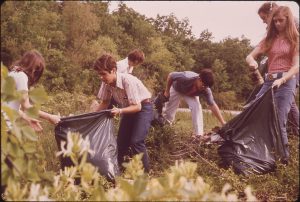Co-authored by Dr. Melissa Swisher, Lecturer, Purdue University
If you’ve been following the March for Science lately, then you already know that students around the world went on strike (Brady & Ludden, 2019) earlier this month to protest institutional policies that ignore and exacerbate climate change (permanent link). Thousands of students missed a day of school for their public demonstrations, a decision that has been a point of criticism for some. Missing a day of school, however, was successful in getting attention. The inconvenience of a public demonstration is one of the strategies that many other successful movements have employed (see Mattaini, 2013 for other examples of strategic nonviolent options to promote change presented from a behavioral perspective). The most recent demonstration from these passionate and highly motivated teens who participated in and organized climate protests in the United States advocated for Congress to adopt the Green New Deal in order to shift to renewable energy sources by 2030.
Student activism isn’t new, and it happens so often there are guides available for those who want to get involved. Yet, despite several recent examples of student activism (e.g., Astor, 2018; Jason, 2018; Whitford, 2019), educators in general aren’t well-known for encouraging student activism and neither are behavior analysts in particular. Nevertheless, we should care because many students have expressed interest in activism and social issues, and behavior analysis might have something to offer (Malott, 2016).

But for some behavior analysts achieving Skinner’s (1987) dream of changing the world with behavior analysis is a reality (see also Chance, 2007; Dixon, Belisle, Rehfeldt, & Root, 2018; Rumph, 2005). Consider some recent examples of activism and advocacy that people like Kathleen Kinkade (Altus, 2009), Molly Benson (2017), Tony Nevin (2018), and Henry Schlinger, Jr. (2018) have personally realized by founding a Walden (Twin Oaks) community, participating in grassroots campaigns for community issues like zoning and immigration, and lending a public voice to The Venus Project, respectively.

We need cooperation to effect change (see Neuringer & Oleson, 2010; Nevin, 2010), which means we need to understand the mechanisms involved in getting people to work together toward a desired outcome, a focus in Cultural Behavioral Systems Science (cf., Glenn et al. 2016). Cooperation to enact change might mean international (Cihon, Artoni, Cavallini, & Corsano, 2018) and interdisciplinary partnerships (Brady, 1993) so we can truly experience freedom from aversive control with short- and long-term reinforcers (Cardinali de Fernandes & Dittrich, 2018).

Image credits:
- Cover image provided courtesy of N Jilderda under Pexels License
- Image provided courtesy of Pixabay under Pexels License
- Image provided courtesy of Olive, Jim under the Public Domain
- Image provided courtesy of Matheus Bertelli under Pexels License
